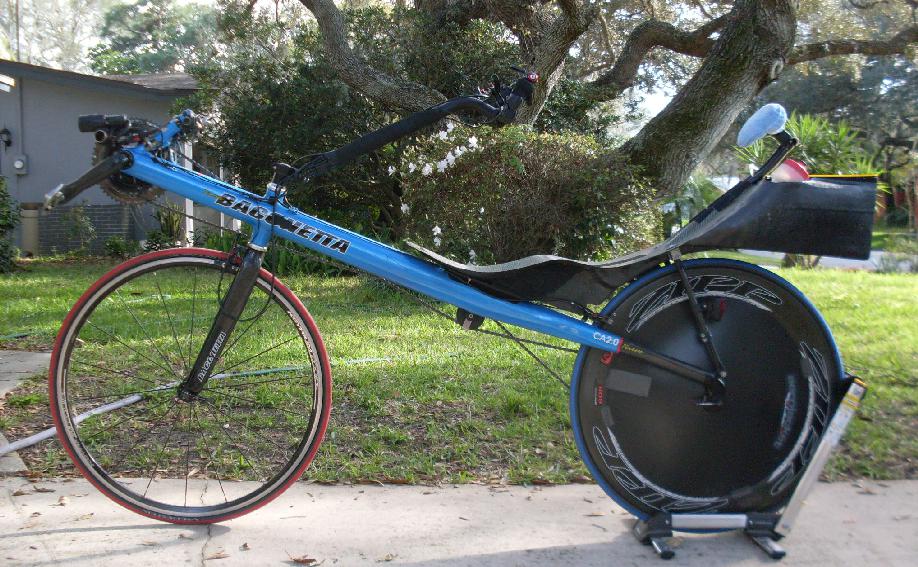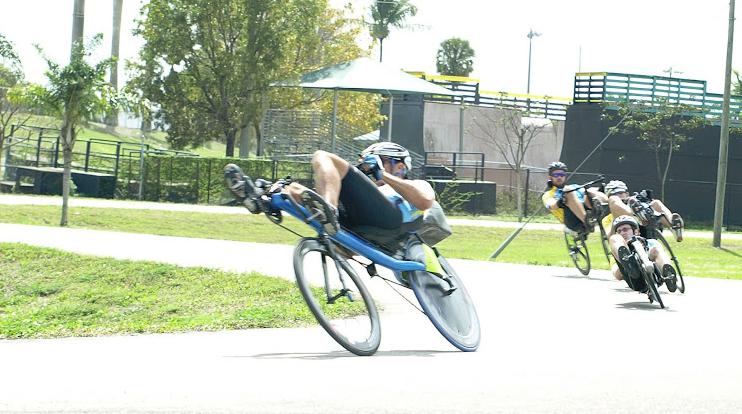

This CA2 frame won Sebring both times it competed. Jim Verheul won 2012 Sebring on it and I won 2013 Sebring on so I think it has a pretty good history. It also performed fabulously during the Cross Florida 2013 ride and one last race at Calvin's Challenge. I rode the same frame during RAAM 2012 but with an earlier version of the splitter rib seat and standard tweener handlebars. The mold for this seat was used as a basis for the RailGun seat. The lumbar support was further modified and rear flanges were added to more properly support a tailbox.
The bike was loaned to JV for Sebring 2012 before I got it. It was a factory defect and then the paint was damaged in several places sometime during Sebring 2012. Somewhere in the process of installing or removing the cranks JV used for Sebring, the BB threads were torn out substantially, making it basically an unusable/unsellable frame. I obtained the frame after Sebring to prepare for RAAM 2012. I spent a substantial amount of time very carefully cleaning and re-tapping the BB threads and then mounted my Lightning Bikes 165mm carbon crankset with Quarq Cinqo power meter in the BB with a 53/38 ring double.
I designed and built the carbon fiber racing seat and tailbox. The top layer of the seat is a Kevlar/carbon fiber weave. Matt Avila helped me get started with building carbon fiber when we did an earlier prototype seat.
The seat is designed for racing. It is is designed to correctly support the body for long periods of time under power. The seatpan is cupped to better support your pelvis but not put pressure on your sacrum and tailbone. I spent months designing and testing the mold and built a couple of early prototypes to check things out. It is lighter, stronger and more flexible in the correct places than any of the stock seats. It is also far more aerodynamic than the stock seat. It incorporates a number of features that allow this, including a sort of splitter rib that improves speeds under almost all wind angles. I've been researching the issues for several years and have been developing some theories on how to improve the situation. The seat was built to test those theories. They turned out to be very successful, especially when you look at the Sebring results. As mounted, the seat angle is about 4-5 deg measured but is effectively lower due to the seatpan and back having less flair.
There has been some discussion regarding "Bacchetta" moving to low seat angles. The low seat angles, meaning (to me) less than 12 degrees was initially done by John Tanner and me, with the technical assistance of John Schlitter and Rich Pinto. Other than John and Rich, I know of no noone else at Bacchetta who wanted to support seat angles at less than about 24 degrees. I did experience a lot of resistance to low seat angles from the folks at Bacchetta.
The carbon fiber tailbox is bonded directly to the seat. The seat angle is so low that it would be impractical to use a fabric tailbox. The tailbox is designed to carry two water bottles in the side pockets and a half-gallon carton of milk or such, along with a bunch of other groceries as it is also my primary transportation, thus also my shopping bike. I attempted to build the tailbox with 4 bottle holders and the plug mold I made for this was made for 4 holders. Unfortunately, I couldn't get the box with 4 holders to properly attach to the seat in a usable fashion so had to hack the front of the box up a bit in order for the mounting straps to work and the box lost its nicely sculptured transition there...
The headrest mount is built into the seat and is the most comfortable headrest especially for a low angle seat I have ever tried. The headrest is easily removable and just slides out. No hardware is needed to hold it in place.
The tiller hardware uses an old RANS flip stem that I flipped around backwards and then drilled and tapped for vertical stops to keep it from dropping too low and becoming unstable. Attached to the stem is a shortened Bacchetta Agio adjustable riser and some old chopped Bacchetta bars that were damaged in a crash a few years ago with some cut off mountain bike bar ends mounted with SRAM shifters on top. Brake levers are mounted on the chopped bars inboard from the bar ends.
If I wasn't moving to a new bike, I would most likely go with a TerraCycle GlideFlex stem instead of the modified RANS. The Glideflex appears to have a reasonable vertical stop offset adjustment and what I believe would be reasonable behavior from the pivot system. I haven't tried the GlideFlex on this bike though so am not certain.
Note: Terracycle is now refusing to sell their GlideFlex stems for this use. Earlier, Terracycle was recommending a particular bike shop for performing the required modification to the GlideFlex stem in order to be used with low seat angle bikes but I was told later by them that RANS and Bacchetta bikes weren't made for low seat angles and the GlideFlex shouldn't be used for them (then why do the seat stays allow it and why was Bachetta recommending low seat angles earlier?). In reality the CA2, while a decent stickbike, is not competitive with modern S-frame bikes such as the M5 CHR. The CHR tiller is easier to work with than a tiller on the CA2 so I would suggest moving to something like the CHR that really is designed for low seat angle use.
One has to somewhat re-learn how to ride a bike again as the tiller arrangement tends to not separate roll from yaw too well but out of a 1-4 comparison of different aspects, the best tweener bar arrangement I was running for a low seat angle I would rate a 1 while this rates a 3. It took me a bit to learn how to not oversteer so I could ride in a tight pack again. Unfortunately, the bike is so fast now that I basically have to ride at two-thirds power in order to stay with a fast df paceline. At speed you don't swivel the bars so much as you torque the bar ends. Reminds one somewhat of an airplane yoke for you fellow (ex-) pilots. I haven't done any high-speed descents with the tiller steering, but the extra-long tweener bars I ran for RAAM 2012 were more than interesting at up around 60mph with a rough road and side-gusts and I don't think this would be much worse.
I made the bars mainly as an experiment to see how well they would work to improve visibility and with sharp turning and they worked so well that I kept them. No more shin divots! No more getting my shoe jammed between the bars and the pedal on sharp, low speed turns. They are very slightly more aero.
Most aspects of the handlebars are more relaxed but not all. There is some stress on my forearms that becomes noticeable after about 20 hours on the bike that doesn't exist with the tweener bars. Not bad but they were a little sore after 24hr of Sebring. I haven't had time to evaluate the cause. Might be that I was just clenching the thing a little too much.
The long tiller is not a problem at low speeds or steep climbs and is actually easier to deal with in very tight turns than any of my other bar arrangements I've used with the seat angle below about 18 degrees and far better than what I used during RAAM 2012. A week after Sebring 2013 we did the Florida Challenge HPV races on the crit course Saturday and the bike was noticably faster and more stable in the tight turns than with the tweener bars I was running last year on the same bike. Even though I was still quite a bit more trashed from Sebring due to the harder conditions this year so didn't quite have the power or endurance, the bike performed better. On Sunday I didn't have a chance to do a trial run at power in the Velodrome so had a little bit of instability in the 200 meter sprint due to inexperience with the slightly different control issues when running at power on the banked turns. I worked it out towards the end of the sprint so didn't have any trouble with the remaining velodrome races.

I believe I have picked most of the low-hanging fruit from the Bacchetta orchard with this bike. Since B indicated to me that they are happy with what they have and are no longer interested in supporting racing or further performance improvements to their bikes, I think it's time to move on. The experiments I've run so far have led me to a slightly new bike design that isn't available anywhere so it appears I have my work cut out for me. In the meantime, I'll soon be attempting to adapt my seat and tailbox to an M5 Carbon High racer. (John Schlitter is riding an M5 highracer behind Mike Mowett on his M1 lowracer in the picture above)
It has been brought to my attention that the above statement regarding Bacchetta has been misinterpreted to suggest that I quit racing for Bacchetta and I chose to race something else. I have always dealt with Bacchetta personnel in a professional manner and was simply doing so above also. Though we still own six Bacchettas, Bacchetta has made it very clear that they don't want me to ride for them or participate in the Bacchetta community any more for reasons I haven't ascertained. I am simply complying with their wishes regarding what I personally ride and race with (and I am blocked from their forum) that it not be a Bacchetta. I am still glad to help individual Bacchetta riders create a more efficient, comfortable and fun bike.
I do want to personally thank John and Jacquie at Vite Bikes for stepping up and helping me get started racing for them on an M5 in light of the above. The old CA2-700 went to a good home and I wish it and it's new rider well. It was a great bike.
Home | RailGun Performance Seat | Contact |
Nov 29, 2014